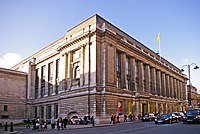Science Museum

|
|
| Data | |
|---|---|
| place | London , England |
| opening | 1857 |
| Number of visitors (annually) | 3,356,212 (2015) |
| management | |
| Website | |
The Science Museum (German Science Museum ) is a museum in London , district of South Kensington , Cromwell Road, where the representation of the development of research and technology is central. It is part of the National Museum of Science and Industry . The museum is a London tourist attraction and entry is free.
history
Today's Science Museum was founded in 1857. It used to be called the South Kensington Museum. At that time it still belonged to the Victoria and Albert Museum opposite , but was made independent of this in 1909 and moved into Richard Allison's building in 1913. Prince Albert and Sir Henry Cole built up the collection with funds from the Great Exhibition. In 1909 the museums were divided. The museum is now part of the former National Museum of Science and Industry , which was renamed the Science Museum Group on April 1, 2012 . This museum network also includes the Museum of Science and Industry in Manchester and the National Railway Museum in York .
With the reopening in August 2020, the Science Museum has ended its longest closure since the Second World War due to the COVID-19 pandemic .
Exhibitions
The museum consists of five levels in which various galleries in the fields of astronomy , meteorology , biochemistry , electronics , navigation , aviation and photography are presented. Notable pieces include a telescope by Galileo Galilei and a microscope by George Adams , the oldest steam locomotive in the world, " Puffing Billy ", the world's first telephone by Alexander Graham Bell and an old car from Rolls-Royce .
In 1980 the "Wellcome Museum" (Museum of the History of Medicine) based on the collection of Henry Wellcome was housed in the Science Museum. The Wellcome Wing of the Science Museum documents the most modern science , industry , medicine and technology in a vivid way.
On the fifth level there is a series of dioramas which clearly show the various medical treatment methods from the most varied of epochs from ancient Egypt to the present day (“Glimpses of Medical History”) .
The history of medicine is the subject of the sixth. This is where "The Science and Art of Medicine" is housed, where the most varied treatment methods can be found, broken down by time period.
Attached to the museum is a 3D - IMAX movie theater.
Science Museum at Wroughton
As with all technical museums, only a fraction (here less than 10%) of the collection can be shown in the Science Museum, the majority is in storage. In particular, there is not enough space in the Blythe House archive in London for large-volume exhibits . In the 1970s, therefore, began to move the aircraft to the former RAF airfield from the Second World War in Wroughton near Swindon ( Wiltshire ). Over 18,000 large-volume collection items are now stored in seven former hangars . The collection is currently only accessible to groups by prior registration. (Coordinates of the entrance: 51 ° 30 ′ 38 ″ N , 1 ° 48 ′ 43 ″ W )
literature
- Science for the Nation: Perspectives on the History of the Science Museum , ed. by Peter JT Morris, Basingstoke [u. a.]: Palgrave Macmillan, 2010
Web links
- Science Museum (English)
- Science Museum at Wroughton (English)
- Amanda Engineer: Illustrations from the Wellcome Library. Wellcome and the "Great Past". Medical History 44, 2000, pp. 389–404, PMC 1044290 (free full text)
Individual evidence
- ↑ http://www.alva.org.uk/details.cfm?p=423
- ^ History of the Science Museum
- ↑ Manchester's MOSI and London's Science Museum to merge . In: BBC News , December 2, 2011. Retrieved September 19, 2012.
- ↑ Humanity versus disease showcased as London's Science Museum reopens doors. In: Reuters. August 11, 2020, accessed on August 11, 2020 .
Coordinates: 51 ° 29 ′ 51 ″ N , 0 ° 10 ′ 27 ″ W.
